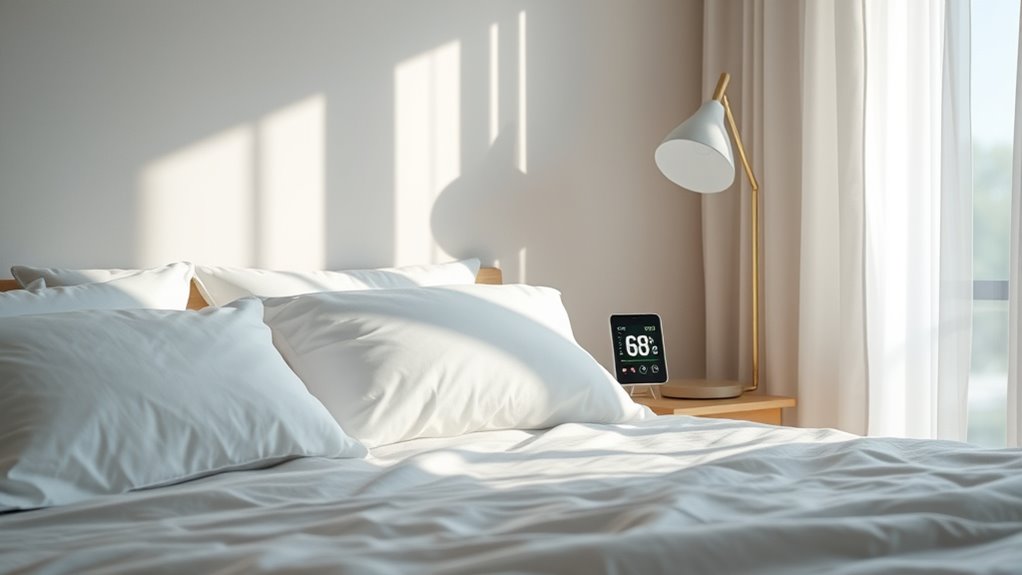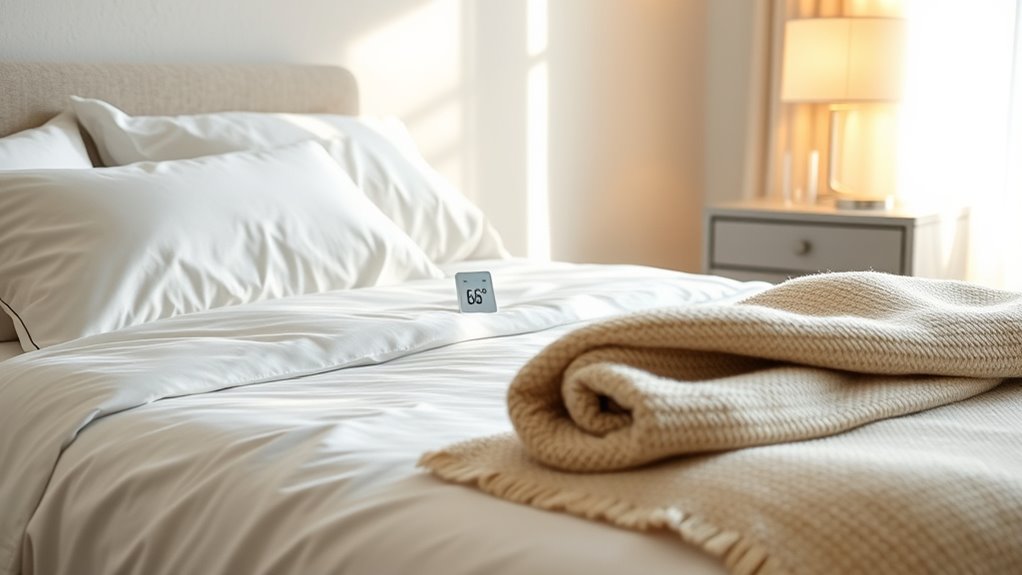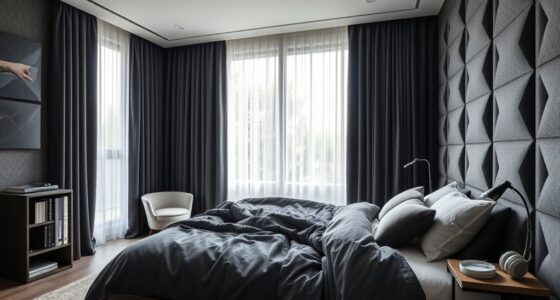Your room temperature directly impacts your sleep quality by affecting your body’s ability to regulate core temperature and shift smoothly through sleep stages. Too hot or cold can cause disruptions, reduce deep sleep, and awaken you. The ideal range of 60-67°F helps your body cool down naturally and promotes restful rest. Keeping your room consistent and comfortable allows you to maximize sleep benefits—stick around to discover simple ways to optimize your sleeping environment.
Key Takeaways
- Cooler room temperatures (60-67°F) support natural thermoregulation, promoting deeper sleep stages.
- Excessive heat can cause discomfort, frequent awakenings, and reduced REM sleep.
- Cold environments may lead to difficulty falling asleep and disrupted sleep cycles.
- Maintaining a consistent room temperature prevents sleep disturbances caused by temperature fluctuations.
- Proper ventilation and breathable bedding enhance thermal comfort, improving overall sleep quality.
The Science Behind Sleep and Temperature Regulation

Understanding how your body regulates temperature is key to grasping how sleep works. Your thermoregulation mechanisms control your core body temperature, helping you feel comfortable and ready for rest. As evening approaches, your circadian rhythm cues signal your body to cool down, lowering your core temperature to promote sleepiness. This natural temperature drop occurs partly through blood vessel dilation and heat loss through your skin. These processes are synchronized with your internal clock, ensuring your body temperature peaks and dips at ideal times. When your sleep environment supports these thermoregulatory signals, you’re more likely to fall asleep faster and enjoy restful sleep. Recognizing how your body responds to circadian cues helps you create conditions that facilitate natural temperature regulation and better sleep quality. Regularly adjusting your room temperature can optimize these processes, supporting airless sprayers and other equipment in excellent condition.
How Temperature Impacts Sleep Stages and Patterns

Temperature plays a crucial role in shaping your sleep stages and overall sleep quality. When your room is too hot or cold, your sleep cycle can become disrupted, making it harder to reach deep sleep or REM stages. Achieving thermal comfort helps your body naturally progress through sleep stages smoothly. Maintaining an ideal temperature helps your body transition through sleep stages more efficiently, ensuring restorative rest and better overall sleep quality. For optimal sleep, thermal regulation is essential to prevent disturbances caused by temperature fluctuations.
Identifying the Ideal Bedroom Climate for Restful Sleep

Finding the right bedroom climate is essential for restful sleep, as your body functions best within a specific temperature range. To identify this ideal environment, consider how sleepwear comfort and bedding materials influence your sleep. Lightweight, breathable fabrics like cotton or linen help regulate body heat, preventing overheating. Opt for bedding materials that wick moisture away and promote airflow, such as breathable sheets and comforters. Your ideal temperature usually falls between 60-67°F (15-19°C), but personal preferences vary. Pay attention to how your sleepwear and bedding feel; if you’re too hot or cold, adjust layers accordingly. Creating a consistent, comfortable climate encourages your body to relax and enter deeper sleep stages, improving overall sleep quality. Ensuring proper micro-mobility arrangements in your space can also contribute to a more comfortable sleep environment by reducing noise and disturbances.
Common Temperature-Related Sleep Disruptions and How to Avoid Them

When your bedroom climate isn’t just right, it can lead to common sleep disruptions that prevent you from getting restorative rest. Temperature fluctuations during the night can cause you to wake up feeling cold or hot, disrupting your sleep cycle. To avoid this, bedding adjustments are essential; adding or removing blankets helps maintain a stable comfort level. Additionally, selecting cozy textiles like blankets and throws can enhance thermal comfort throughout the night.
Tips for Maintaining the Perfect Sleeping Environment

Creating the ideal sleeping environment requires paying close attention to several key factors that influence comfort and sleep quality. Start by choosing the right bedding materials—breathable sheets and a comfortable mattress help regulate temperature and prevent overheating or chills. Incorporate sleep accessories like a fan, blackout curtains, or white noise machines to enhance comfort and minimize disruptions. Keep your room at a consistent, cool temperature—around 60-67°F—and adjust bedding accordingly for seasonal changes. Avoid clutter and ensure proper ventilation to promote airflow. Investing in quality sleep accessories that suit your preferences, whether that’s cooling pillows or cozy blankets, can make a significant difference. Maintaining a clean, quiet, and dark environment creates the perfect setting for restful sleep and helps your body stay in equilibrium throughout the night. Additionally, understanding the impact of sound and other sensory factors can further optimize your sleep quality.
Frequently Asked Questions
How Does Room Temperature Affect Sleep Quality in Different Age Groups?
You might notice that your sleep quality varies with room temperature, and age-specific comfort plays a role. Younger people often prefer slightly cooler settings, while older adults may need warmer temperatures for better rest. Your body’s temperature regulation changes over time, influencing your temperature preferences. By adjusting your room to match your age-specific comfort needs, you can improve sleep quality and wake up feeling more refreshed every morning.
Can Adjusting Room Temperature Improve Sleep for People With Insomnia?
Did you know that adjusting your bedroom temperature can boost sleep quality for people with insomnia? You can improve your sleep environment by setting your room to a comfortable 60-67°F, which enhances temperature comfort and promotes faster sleep onset. By fine-tuning your room temperature, you create a more conducive sleep environment, helping you fall asleep quicker and enjoy more restful nights. Small changes in temperature can make a significant difference.
What Are the Long-Term Health Effects of Sleeping in a Suboptimal Temperature?
Sleeping in a suboptimal temperature can impact your thermal comfort and may lead to long-term health issues. You might experience disrupted sleep, affecting your metabolic health, and increasing risks like weight gain or cardiovascular problems. Consistently poor thermal comfort strains your body’s ability to regulate temperature, which could weaken your immune system over time. To protect your health, aim for a comfortable sleeping environment that supports ideal sleep quality and long-term well-being.
How Does Room Temperature Influence Dreams and REM Sleep?
You might find that room temperature influences your dreams and REM sleep. Cooler temperatures tend to enhance REM duration, leading to more vivid dreams and better dream recall. Conversely, warmer rooms can disrupt REM cycles, causing lighter sleep and fewer memorable dreams. Evidence suggests that maintaining a comfortable, slightly cool environment helps optimize REM sleep, allowing you to experience more restful nights with richer dreams.
Are There Cultural Differences in Preferred Bedroom Temperatures for Sleep?
You might notice that cultural sleep practices influence preferred bedroom temperatures, shaped by regional climate preferences. In warmer regions, people often favor cooler rooms to stay comfortable, while in colder areas, warmer environments are common. These cultural differences impact your sleep quality because your body adapts to your typical temperature range. So, understanding regional climate preferences helps you tailor your sleep environment for better rest.
Conclusion
By balancing your bedroom’s temperature, you boost better sleep and banish bothersome disruptions. Creating a cozy, consistent climate calms your body, cultivates clarity, and encourages restful nights. Remember, a cool, comfortable space is key to keeping sleep simple, serene, and satisfying. So, stay mindful of your environment, tweak your temps, and enjoy the sweet, sound sleep you deserve. Your ideal atmosphere awaits — aim for ambiance that awakens your well-being.









